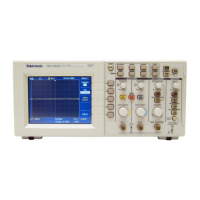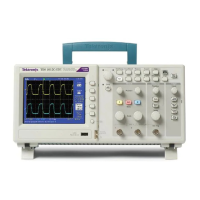Command Syntax
2-2
TDS200, TDS1000/2000, TDS1000B/2000B, TPS2000 Programmer
The Bac kus Naur Form (BNF) notati on is used in this manual to
describe commands and queries. Table 2--2 lists the BNF notation.
Table 2- 2: BNF notation
Symbol Meaning
<>
Defined element
::= Is defined as
| Exclusive OR
{}
Group; one element is required
[]
Optional; can be omitted
... Previous element(s) may be
repeated
()
Comment
Command and Query Structure
Commands consist of set commands and query commands (usually
simply called commands and queries). Commands change oscillo-
scope settings or pe rform a speci fic action. Queries cause the
oscilloscope to return data and information about its status.
Most commands have both a set form and a query form. The query
form of the command is the same as the set form except t hat it ends
with a question mark. For example, the set command ACQuire:MODe
has a que ry form ACQuire:MODe?. Not all commands have both a set
and a query form; some commands are set only and some are query
only.
A few commands do both a set and query acti on. For exampl e, the
*CAL? command runs a self-calibration program on the oscilloscope,
then returns the result of the calibration.
A command message is a command or query name, followed by any
information the oscilloscope needs to execute the command or query.
Command messages consist of five different element types.

